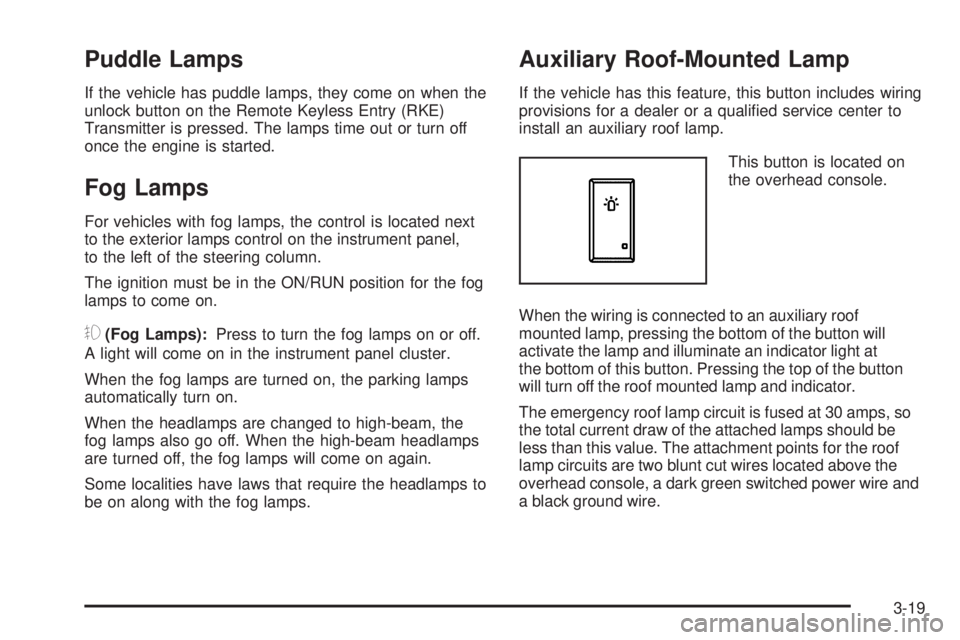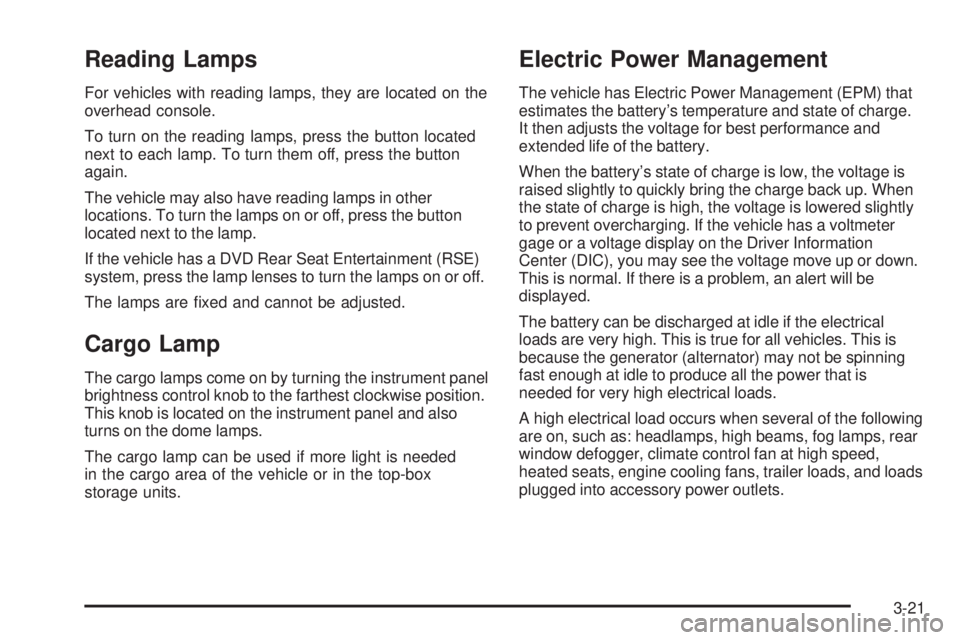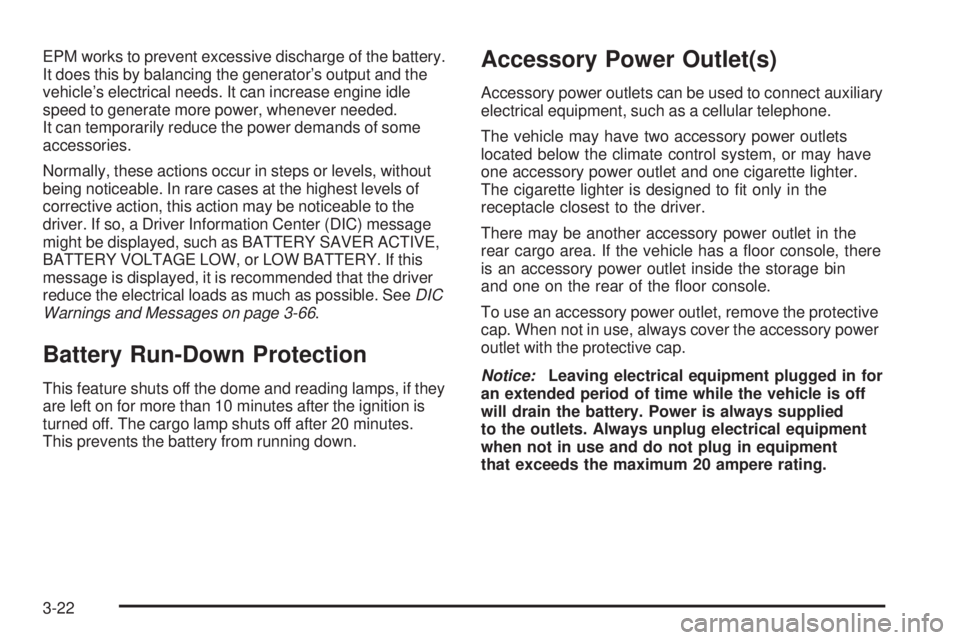2009 GMC SIERRA 1500 center console
[x] Cancel search: center consolePage 100 of 602

Park Tilt Mirrors............................................2-60
Outside Convex Mirror...................................2-60
Outside Heated Mirrors..................................2-60
Object Detection Systems...............................2-61
Ultrasonic Rear Parking Assist (URPA)............2-61
Rear Vision Camera (RVC)............................2-64
OnStar
®System.............................................2-70
Universal Home Remote System......................2-73
Universal Home Remote System Operation
(With Three Round LED)............................2-74Storage Areas................................................2-80
Glove Box...................................................2-80
Cupholders..................................................2-80
Instrument Panel Storage...............................2-81
Center Console Storage.................................2-81
Luggage Carrier...........................................2-82
Rear Seat Armrest........................................2-82
Cargo Management System...........................2-83
Sunroof.........................................................2-84
Section 2 Features and Controls
2-2
Page 178 of 602

Using Universal Home Remote
Press and hold the appropriate button for at least
half of a second. The indicator light will come on while
the signal is being transmitted.
Reprogramming Universal Home
Remote Buttons
Any of the three buttons can be reprogrammed by
repeating the instructions.
Erasing Universal Home Remote
Buttons
The programmed buttons should be erased when the
vehicle is sold or the lease ends.
To erase either Rolling Code or Fixed Code on the
Universal Home Remote device:
1. Press and hold the two outside buttons at the same
time for approximately 20 seconds, until the
indicator lights, located directly above the buttons,
begin to blink rapidly.
2. Once the indicator lights begin to blink, release both
buttons. The codes from all buttons will be erased.
For help or information on the Universal Home Remote
System, call the customer assistance phone number
underCustomer Assistance Offices on page 7-6.
Storage Areas
Glove Box
Lift up on the glove box lever to open it.
Cupholders
Vehicles with cupholders, have them located on and
behind the center console and in the rear seat armrest.
Pull the loop down on the rear seat armrest to access
the cupholders.
Pull downward on the lid to access the cupholders
behind the center console.
2-80
Page 179 of 602

Instrument Panel Storage
Vehicles that have an instrument panel storage area,
have it located above the glove box.
Press and hold the driver side of the handle in and pull
out on the exposed portion of the handle to access
the storage area.
Center Console Storage
Vehicles with an upper and lower center console
storage area, cupholders are included.
Pull the lever (A) up to access the upper storage area.
Raise the upper storage bin, then pull the lever (B)
up to access the lower storage area. Use the key to lock
and unlock the lower storage area.
2-81
Page 203 of 602

Puddle Lamps
If the vehicle has puddle lamps, they come on when the
unlock button on the Remote Keyless Entry (RKE)
Transmitter is pressed. The lamps time out or turn off
once the engine is started.
Fog Lamps
For vehicles with fog lamps, the control is located next
to the exterior lamps control on the instrument panel,
to the left of the steering column.
The ignition must be in the ON/RUN position for the fog
lamps to come on.
#(Fog Lamps):Press to turn the fog lamps on or off.
A light will come on in the instrument panel cluster.
When the fog lamps are turned on, the parking lamps
automatically turn on.
When the headlamps are changed to high-beam, the
fog lamps also go off. When the high-beam headlamps
are turned off, the fog lamps will come on again.
Some localities have laws that require the headlamps to
be on along with the fog lamps.
Auxiliary Roof-Mounted Lamp
If the vehicle has this feature, this button includes wiring
provisions for a dealer or a quali�ed service center to
install an auxiliary roof lamp.
This button is located on
the overhead console.
When the wiring is connected to an auxiliary roof
mounted lamp, pressing the bottom of the button will
activate the lamp and illuminate an indicator light at
the bottom of this button. Pressing the top of the button
will turn off the roof mounted lamp and indicator.
The emergency roof lamp circuit is fused at 30 amps, so
the total current draw of the attached lamps should be
less than this value. The attachment points for the roof
lamp circuits are two blunt cut wires located above the
overhead console, a dark green switched power wire and
a black ground wire.
3-19
Page 205 of 602

Reading Lamps
For vehicles with reading lamps, they are located on the
overhead console.
To turn on the reading lamps, press the button located
next to each lamp. To turn them off, press the button
again.
The vehicle may also have reading lamps in other
locations. To turn the lamps on or off, press the button
located next to the lamp.
If the vehicle has a DVD Rear Seat Entertainment (RSE)
system, press the lamp lenses to turn the lamps on or off.
The lamps are �xed and cannot be adjusted.
Cargo Lamp
The cargo lamps come on by turning the instrument panel
brightness control knob to the farthest clockwise position.
This knob is located on the instrument panel and also
turns on the dome lamps.
The cargo lamp can be used if more light is needed
in the cargo area of the vehicle or in the top-box
storage units.
Electric Power Management
The vehicle has Electric Power Management (EPM) that
estimates the battery’s temperature and state of charge.
It then adjusts the voltage for best performance and
extended life of the battery.
When the battery’s state of charge is low, the voltage is
raised slightly to quickly bring the charge back up. When
the state of charge is high, the voltage is lowered slightly
to prevent overcharging. If the vehicle has a voltmeter
gage or a voltage display on the Driver Information
Center (DIC), you may see the voltage move up or down.
This is normal. If there is a problem, an alert will be
displayed.
The battery can be discharged at idle if the electrical
loads are very high. This is true for all vehicles. This is
because the generator (alternator) may not be spinning
fast enough at idle to produce all the power that is
needed for very high electrical loads.
A high electrical load occurs when several of the following
are on, such as: headlamps, high beams, fog lamps, rear
window defogger, climate control fan at high speed,
heated seats, engine cooling fans, trailer loads, and loads
plugged into accessory power outlets.
3-21
Page 206 of 602

EPM works to prevent excessive discharge of the battery.
It does this by balancing the generator’s output and the
vehicle’s electrical needs. It can increase engine idle
speed to generate more power, whenever needed.
It can temporarily reduce the power demands of some
accessories.
Normally, these actions occur in steps or levels, without
being noticeable. In rare cases at the highest levels of
corrective action, this action may be noticeable to the
driver. If so, a Driver Information Center (DIC) message
might be displayed, such as BATTERY SAVER ACTIVE,
BATTERY VOLTAGE LOW, or LOW BATTERY. If this
message is displayed, it is recommended that the driver
reduce the electrical loads as much as possible. SeeDIC
Warnings and Messages on page 3-66.
Battery Run-Down Protection
This feature shuts off the dome and reading lamps, if they
are left on for more than 10 minutes after the ignition is
turned off. The cargo lamp shuts off after 20 minutes.
This prevents the battery from running down.
Accessory Power Outlet(s)
Accessory power outlets can be used to connect auxiliary
electrical equipment, such as a cellular telephone.
The vehicle may have two accessory power outlets
located below the climate control system, or may have
one accessory power outlet and one cigarette lighter.
The cigarette lighter is designed to �t only in the
receptacle closest to the driver.
There may be another accessory power outlet in the
rear cargo area. If the vehicle has a �oor console, there
is an accessory power outlet inside the storage bin
and one on the rear of the �oor console.
To use an accessory power outlet, remove the protective
cap. When not in use, always cover the accessory power
outlet with the protective cap.
Notice:Leaving electrical equipment plugged in for
an extended period of time while the vehicle is off
will drain the battery. Power is always supplied
to the outlets. Always unplug electrical equipment
when not in use and do not plug in equipment
that exceeds the maximum 20 ampere rating.
3-22
Page 589 of 602

Bulb Replacement (cont.)
License Plate Lamps....................................5-65
Pickup Box Identi�cation and Fender Marker
Lamps ....................................................5-63
Taillamps, Turn Signal, Stoplamps and
Back-up Lamps........................................5-63
Buying New Tires...........................................5-86
C
Calibration.....................................................3-63
California
Perchlorate Materials Requirements................. 5-5
California Fuel.................................................. 5-7
California Proposition 65 Warning....................... 5-5
Camera, Rear Vision.......................................2-64
Canadian Owners............................................... iii
Capacities and Speci�cations..........................5-131
Carbon Monoxide
Engine Exhaust...........................................2-55
Tailgate......................................................2-13
Winter Driving.............................................4-30
Care of
Safety Belts..............................................5-118
Cargo
Lamp .........................................................3-21Cargo Management System.............................2-83
CD, MP3 ............................................3-106, 3-111
Center Console Storage...................................2-81
Center High-Mounted Stoplamp (CHMSL) and
Cargo Lamp...............................................5-62
Center Seat...................................................1-13
Chains, Tire...................................................5-92
Charging System Light....................................3-41
Check
Engine Lamp..............................................3-45
Checking Things Under the Hood......................5-14
Chemical Paint Spotting.................................5-122
Child Restraints
Infants and Young Children...........................1-41
Lower Anchors and Tethers for Children..........1-49
Older Children.............................................1-38
Securing a Child Restraint in a Rear Seat
Position..................................................1-58
Securing a Child Restraint in the Center
Front Seat Position...................................1-61
Securing a Child Restraint in the Right
Front Seat Position..................1-62, 1-66, 1-70
Systems.....................................................1-45
Where to Put the Restraint...........................1-48
Cigarette Lighter.............................................3-23
Circuit Breakers............................................5-124
3
Page 600 of 602

Snow Plow....................................................4-40
Spare Tire....................................................5-114
Installing...................................................5-100
Removing...................................................5-95
Storing.....................................................5-110
Speci�cations and Capacities..........................5-131
Speedometer..................................................3-35
StabiliTrak
®Indicator Light...............................3-44
StabiliTrak®System.......................................... 4-6
Start Vehicle, Remote....................................... 2-7
Starting the Engine.........................................2-24
Steering.......................................................... 4-9
Steering Wheel Controls, Audio.......................3-140
Steering Wheel, Tilt Wheel................................. 3-8
Storage Areas
Cargo Management System..........................2-83
Center Console...........................................2-81
Cupholders.................................................2-80
Glove Box..................................................2-80
Instrument Panel.........................................2-81
Luggage Carrier..........................................2-82
Rear Seat Armrest.......................................2-82
Stuck in Sand, Mud, Ice, or Snow.....................4-32
Sun Visors.....................................................2-18
Sunroof.........................................................2-84
T
Tachometer....................................................3-35
Tailgate.........................................................2-13
Taillamps
Turn Signal, Stoplamps and Back-up Lamps....5-63
Tampering with Noise Control System
Prohibited...................................................5-57
Text Telephone (TTY) Users............................... 7-6
Theft-Deterrent Feature..................................3-140
Theft-Deterrent Systems...................................2-18
Content Theft-Deterrent................................2-18
PASS-Key
®III+ Electronic Immobilizer............2-20
PASS-Key®III+ Electronic Immobilizer
Operation................................................2-20
Throttle, Adjustable..........................................2-26
Tilt Wheel........................................................ 3-8
Time, Setting..................................................3-85
Tire
Pressure Light.............................................3-45
Tires.............................................................5-67
Aluminum or Chrome-Plated Wheels,
Cleaning...............................................5-120
Buying New Tires........................................5-86
Chains.......................................................5-92
Changing a Flat Tire....................................5-94
14